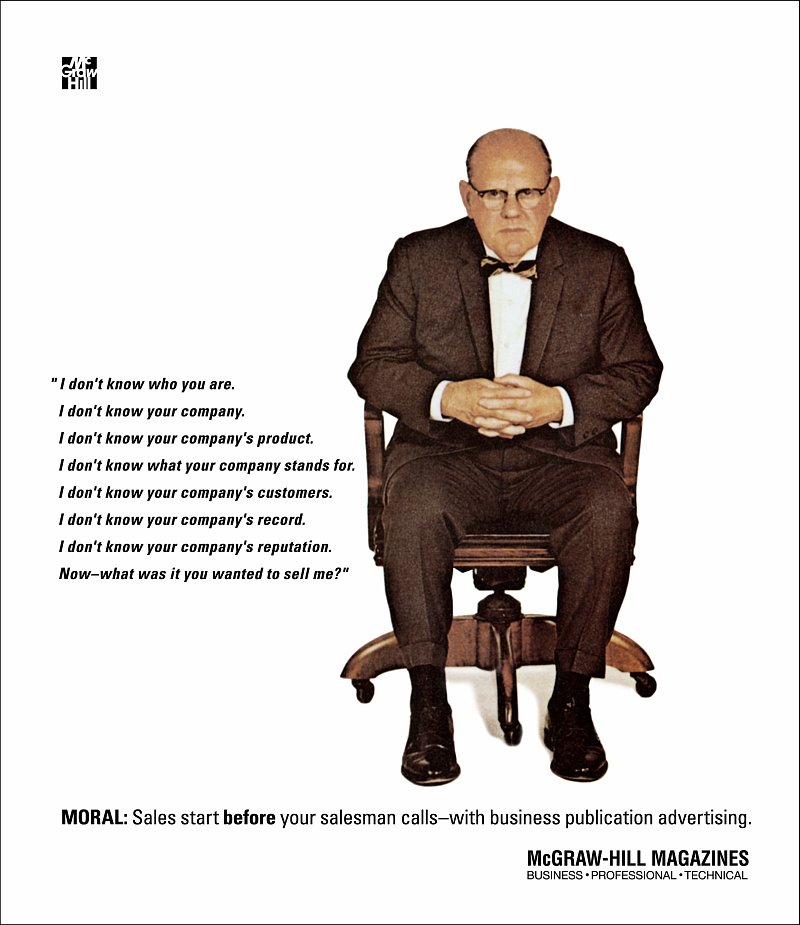 I can remember it like it was yesterday: I and some others from my agency team along with the client’s CMO were sitting in the office of the CEO for a Fortune 100 company presenting the advertising campaign for the year. The CEO looked at us and pointedly said, “Strategy is results!” What he meant was that the strategy doesn’t matter as long as you are producing results. This CEO saw: strategy = analysis and execution = getting things done, and he attributed more value to doing than to analyzing. Strategy statements like “Being the brand of choice in the vertical markets we serve” and similar statements were not for him. And frankly, I’m not a fan of them either.
I can remember it like it was yesterday: I and some others from my agency team along with the client’s CMO were sitting in the office of the CEO for a Fortune 100 company presenting the advertising campaign for the year. The CEO looked at us and pointedly said, “Strategy is results!” What he meant was that the strategy doesn’t matter as long as you are producing results. This CEO saw: strategy = analysis and execution = getting things done, and he attributed more value to doing than to analyzing. Strategy statements like “Being the brand of choice in the vertical markets we serve” and similar statements were not for him. And frankly, I’m not a fan of them either.
But, any seasoned marketer knows that a marketing strategy is about the series of choices you make on where to play and how to win to maximize long-term value. Execution is producing results in the context of those choices. Therefore, you can’t have good implementation without having good strategy. Most everyone would agree that you just can’t achieve good results without having good execution; similarly, most would agree that having a good strategy alone is no guarantee for success. But, too many jump to the wrong conclusion that this makes execution or implementation more important than strategy. OK, so let’s look at that for a moment.
It’s pretty obvious to all that creating “The Strategy” is cool…it’s sexy. And who wouldn’t want to be part of the team that developed “The Strategy,” right? But actually creating it right requires thought, knowledge, and understanding of the audience and marketplace, and creativity. Look at any university setting and you’ll see that MBA courses stress strategy. We worry about social media strategies, mobile marketing strategies, strategies for enhancing customer engagement or customer experience, advertising strategies, SEO strategies, lead generation marketing strategies, sales strategies, and on and on.
You’ll get no argument for me when saying that a well-thought-out and written strategy is critically important to business success. But here’s something that a lot of marketing people don’t always consider to the extent they should: the soft underbelly of strategy is implementation. Without implementation, even the most brilliant strategy is just words, a hope, an untested premise. We all know this intellectually, of course, but we don’t necessarily follow through on that knowledge and make it the priority it should be. Implementation is generally left to some coordinator or least experienced member of the team. Or even to an automated program.
Okay, we all know that the implementation and all the hard work that goes along with putting a strategy into the marketplace has to be done by someone. Initiatives don’t get completed by stating them on paper; they require action, management and follow up. And from my experience working with organizations of various sizes, I’d say that no VP of Marketing or CMO can – or should – try to do everything. But in the same breath, we can’t just assume that everyone who is diligently working on the tactics is actually supporting the overall marketing and business strategy that was created. Implementing different pieces of the program is not the same as true implementation to achieve the organization’s business objectives. Poor tactics, poor coordination, and poor implementation of even a great strategy have led to as many flops as a poorly created strategy.
Here’s a quick real life example: An athletic shoe manufacturer sent me email after email telling me to stop by their upcoming trade show booth, and by turning in a printed copy of the email, I would receive a certificate for significant savings off their athletic shoes. Guess what happened when I showed up at the booth? No one, and I mean NO ONE at the booth knew anything about the offer. “Don’t know what this is all about,” or “No one told us about this,” were all anyone there could say.
So, at the risk of being overly obvious, the heart of the implementation of a marketing plan is the execution, the actual doing of the planned marketing activities. Successful marketing implementation requires:
Mere implementation is not always that difficult. The hard part is implementing things in an organized way. And, it’s the cohesiveness of the strategy’s implementation tactics where the revenues (the results that the Fortune 100 company CEO talked about) will be generated.
####
Rolf Gutknecht is vice president, director of account services for LA ads. To discuss your thoughts with Rolf on this blog or any marketing matters, email via this link, or visit www.LAadsMarketing.com. You can also connect with Rolf on LinkedIn.
 “Life can only be understood backwards; but it must be lived forwards.” – Soren Kierkegaard
“Life can only be understood backwards; but it must be lived forwards.” – Soren KierkegaardThe last quarter of 2016 is almost history and as we stand poised to welcome 2017 in less than 2 weeks, we hope for a future that is successful, rewarding and where your dreams will be realized. Having seen the start of more than a few “new business years” during my career, I’ve learned that you can do one of two things in preparation for the coming year. You can yet again try to create a brand new marketing strategy for the coming year or you can pause, look back and do some serious reflecting, resolving to change, or improve some aspect about how you will initiate your future marketing campaigns. For some people, looking back over the past year may be something better left in the rearview mirror; on the other hand, burying your head in the sand can be seen as the primary ingredient in a recipe for another disappointing year…and you know how much the CEO/President/Owner/Founder loves that kind of thinking. So, before one celebrates the dawn of a new year…take time to ask yourself what are you going to do to change? What does success in 2017 look like to you and your executive management team?
Speaking for myself and our firm, the end of each year is met with a healthy dose of optimism for the coming year. We see 2017 through a lens of hopefulness, that things will continue to get better. Is that just us or will you and your organization also view the coming year with a level of anticipation that you haven’t had for a few years? Hey, it’s been tough for most everyone out there but let’s remember that at least a few organizations — perhaps some of your own competitors — have fared better than most despite these trying times. So what have they done to plot a course for a more optimistic and profitable path for success in 2017?
Depending on marketplace factors coupled with how well you were able to strategically position and market your company, the past year was either seen as a success or another year of same-old, or even a disappointment. The question that begs to be asked here is, how much of last year’s growth or lack thereof was because of something you had no control over, such as good or bad luck, and how much was because of something you specifically chose to do or not do? I’ve found through personal experience this is the time to be totally honest with yourself. As Sigmund Freud said, “Being entirely honest with oneself is a good exercise.”
Hey, I’m all for a bit of luck but you probably don’t want to continue betting future success on lucky things happening in the coming year. With this in mind, here are a few questions to ask yourself as thought starters as you begin the process of looking in the rearview mirror at this past year and through your windshield to the next:
As marketers, one thing we know for sure is that change will not stop in 2017. The marketplace will continue to shift on us, and so will the economy. But by reflecting back on 2016, taking control of your marketing activities rather than being tossed around by the waves in the market, along with thinking optimistically about what 2017 can hold, this New Year might actually be a year worth celebrating. It will be for us and hopefully will be for you as well.
####
Rolf Gutknecht is vice president, director of account services for LA ads. To discuss your thoughts with Rolf on this blog or any marketing matters, email via this link, or visit www.LAadsMarketing.com. You can also connect with Rolf on LinkedIn.
 Just the other day my daughter told me that Facebook let her know that 6 years ago we brought home our German and Australian Shepherd mix whom we named Sadie. While I wasn’t sure we needed another dog at the time, I’m sure glad we decided to do so as Sadie’s been a wonderful dog. I mean, wonderful! So, where’s all this going? Stay with me.
Just the other day my daughter told me that Facebook let her know that 6 years ago we brought home our German and Australian Shepherd mix whom we named Sadie. While I wasn’t sure we needed another dog at the time, I’m sure glad we decided to do so as Sadie’s been a wonderful dog. I mean, wonderful! So, where’s all this going? Stay with me.
In the beginning, we were called by a dog rescue association we had connected with. They said they were getting a few dogs within a couple of days and, based on our interest in the Australian Shepherd breed, we might be very interested. So on that day we went, and while we were playing with the dogs, it became clear that this little one was an “A-personality” pup, full of energy and a little headstrong. When I told my family that she was the one I wanted, they asked why. I told them that I wanted a dog that was going to give me a bit of a run for my money and based on what I saw of her, my thinking was that she’d be the smartest, healthiest and probably the most rascally of the bunch. In this case, I was right and I’m glad I went with Sadie versus some of the other dogs who were more on the passive “follow you all around the house” side. With all that as the backdrop, there’s a lesson here about developing effective, sales-producing marketing campaigns. I told you we were going to get there.
So with all that in mind, let’s go back to my experience in picking Sadie:
When you design your business and marketing strategy, will you go with the easy way – following what others are doing – picking the dog most others would – or do you challenge yourself to go beyond the accepted norms, to think for yourself, to dare to be different, to self-define the limits of what is possible? History has shown the most successful companies have chosen the puppy who doesn’t act like the others.
####
Rolf Gutknecht is vice president, director of account services for LA ads. To discuss your thoughts with Rolf on this blog or any marketing matters, email via this link, or visit www.LAadsMarketing.com. You can also connect with Rolf on LinkedIn.
 Oh, the world of numbers. To those involved in Marketing, it goes with the territory. We look at the marketplace and how many prospective customers there might be. We slice and dice demographic information and analyze demographic trends. We do quantitative market research. We fixate on how many likes, follows, shares, retweets, etc. have occurred. And we’re not finished yet as new and more “effective” metrics are constantly being developed. While tracking marketing numbers isn’t like keeping up with the stats of, say, baseball, for many marketers, numbers are almost everything. And for some, they are everything.
Oh, the world of numbers. To those involved in Marketing, it goes with the territory. We look at the marketplace and how many prospective customers there might be. We slice and dice demographic information and analyze demographic trends. We do quantitative market research. We fixate on how many likes, follows, shares, retweets, etc. have occurred. And we’re not finished yet as new and more “effective” metrics are constantly being developed. While tracking marketing numbers isn’t like keeping up with the stats of, say, baseball, for many marketers, numbers are almost everything. And for some, they are everything.
Now, I’m pretty good at math. So, numbers don’t give me cold sweats, but truth be told, when it comes to marketing, I’m not a Big Data guy at all. I’m not one to get all caught up in the numbers game. The reason being that while I’m an “account guy,” I understand what really good creative, execution and integration will do toward driving sales compared to run-of-the-mill stuff. On more than one occasion, our agency has spoken with prospective clients who tell us how their marketing metrics are sucking wind. Our first response is: “Let’s look at the creative you’re running and what it’s saying.” When it’s shown to us, there’s little doubt what is creating the angst.
For my liking, there are far too many marketers that rely heavily on numbers to drive the marketing decisions. Everything has to have a value and must be measured. A former boss of mine who came from a LARGE national company once said to me after meeting with a “numbers marketer” that marketing is not a paint-by-numbers game where if you follow the color assignments and stay within the lines, the end result would be a beautiful painting. Viola! Instant success…without expending much thought, energy or creativity. And, that’s what I fear is what is happening to marketing.
From where I sit, you can see when this takes place. Look at a TV commercial, or radio spot, or tradeshow booth, or go online. There seems to be more and more marketers who are buying into templates, guides and models. It’s as if the marketplace is just a large paint canvas fractured into tiny parts, which, if you paint each activity with the right color and stay within the lines, you’ll have a winning marketing program. Not so! What I believe happens more times than not is that you don’t end up with a masterpiece but rather a painting of dogs sitting around the table playing poker…you know the one.
For a marketing program to be as clever, contemporary, and inviting enough to gain your audience’s attention, it requires meaningful thought, understanding, listening and… creativity. Uniqueness. Unfortunately, creativity and emotion are often scrubbed clean (and out of the picture) much to the happiness of many marketers who rely merely on data.
Yet some brands manage to break-away from the status quo and attain results. These brands — and those people who oversee them — combine experience and talent with a commitment to being fearless.
And then other brands try to find equal results by copying them. Remember “Got Milk”? Soon after, we saw “Got Plumber” and “Got Rice” and “Got …whatever” In the case of our agency, we developed a marketing program for a client that used a weeping angel statue (like you find in cemeteries) to demonstrate how one would feel using the wrong type of business software. Hardly a few months after, a direct competitor used strikingly similar imagery and messaging. Really?!? I guess imitating was their template to seeing better results rather than trying to come up with something original themselves. They (the competitor) were trying to paint-by-numbers into a template not of their own making.
So what are the takeaways from all of this:
• Having metrics drive all your marketing decisions, void of smart, clever, on-point messaging that resonates with your audience, is a road with a dead-end. Which is probably not what you really want.
• Templates and “how to” guides do not lend themselves to creativity.
• If you are responsible for marketing, it is your job to think differently. Painting by the numbers and staying within the lines won’t yield profits.
• BONUS: “The truth isn’t the truth until people believe you, and they can’t believe you if they don’t know what you’re saying, and they can’t know what you’re saying if they don’t listen to you, and they won’t listen to you if you’re not interesting, and you won’t be interesting until you say and do things imaginatively, originally, freshly.” – Bill Bernbach
In the end, while numbers and data help marketers define the market and opportunities that present themselves, as well as quantifying the buyer’s journey, remember that lasting relationships and brand loyalty are the result of original thinking.
####
Rolf Gutknecht is vice president, director of account services for LA ads. To discuss your thoughts with Rolf on this blog or any marketing matters, email via this link, or visit www.LAadsMarketing.com. You can also connect with Rolf on LinkedIn.
 Here’s an interesting question that you don’t ask yourself every day: If you left your present organization and went to work for a competitor, knowing what you know about your present firm, what would you then do from a marketing standpoint to grow market share at your old company’s expense?
Here’s an interesting question that you don’t ask yourself every day: If you left your present organization and went to work for a competitor, knowing what you know about your present firm, what would you then do from a marketing standpoint to grow market share at your old company’s expense?
As marketers, the tendency is to look at what your competitors are doing and saying and, if important enough, figure out how to mitigate it so it does no harm to your firm. BUT, when you take a look at your own organization through the lens of someone who has inside knowledge about your firm’s “Achilles heel,” as well as the plans you have in place for the future, an entirely different set of issues present themselves. And, that’s a good thing if you do it as part of a healthy review of your business and its marketing activities.
I’ve had business dealings with lots of marketing folks who have left one company to join another whose insights on their past employer have played an important part in the growth of their new firm. Now I know you’re saying, “Well, that isn’t right. People should keep what they know to themselves and not share that at the expense of their past firm.” I hear you, but I have a different view on that. If my job performance and my family and career prospects depend on my being successful, then knowing what I know is going to come into play either consciously or on some other level. And that, my friends, happens all-day every-day in this “new normal” business environment. Putting a company’s marketing efforts on auto-pilot and then playing the “Woe is me” card isn’t going to cut it as an excuse. (NOTE: I’m NOT talking about a former employee illegally or immorally appropriating a company’s passwords or passing along genuine trade secrets or violating terms of an NDA, just to be clear.)
Maybe the best example of what I’m talking about takes place in competitive team sports. Coaches, managers and players are always looking to fine tune areas that they feel the other team could exploit for their benefit. Teams watch films of games and their own practices to identify things that they could be doing better before the other team can identify those problem areas. They talk to players who have come from another team to get some inside intelligence on what other teams see as limitations or flaws. Only taking this knowledge into account and addressing it can the team feel confident that they’re prepared for what lies ahead. It shouldn’t be any different for your company. Taking an introspective look at how or whether your marketing initiatives and business approach is susceptible to a counter attack is something that should be done before current and future plans are placed in jeopardy.
So now the question is, “how do we as an organization start the process?” I’d suggest the first place to start is the good-old, time-tested SWOT analysis, something that can be implemented almost immediately. To begin the process, have those associated with your firm’s marketing functions put together their own SWOT analysis on the specific marketing activities that the company is engaged with, i.e., PR, Tradeshow/Events, Advertising, Social Media, Pricing, Promotion, etc. Then, assemble the team to discuss, review and make decisions on the input with an eye towards creating a next-steps plan to shore up marketing functions and activities that are critical to the success of the company’s integrated marketing program.
Remember, the idea of performing a SWOT analysis is to accomplish two primary things:
One: Reduce Risk. Improve the viability of your company by pairing up external threats with internal weaknesses to highlight the most serious issues faced by your company.
Two: Improve Performance. What actions you should consider to improve the performance of your business by pairing up internal strengths with the external opportunities.
With everything on Marketing’s plate today and the urgency in which it needs to get done, there’s a real danger of losing sight of the basics. Who has the time, right? Well, if we lose sight of the need to regularly and carefully look at what we think our company is (warts and all), particularly in light of all the resources we use or spend in the ever-evolving marketplace – not just our guesses about it – we risk losing all that we work so hard to achieve: increasing revenues and market share.
The time-tested marketing adage has never been more true: If you don’t really know where you are, it is much more difficult to get where you want to be. And knowing what your company’s particular “Achilles Heel” is and taking moves to protect it will go a long way toward your winning the race.
####
Rolf Gutknecht is vice president, director of account services for LA ads. To discuss your thoughts with Rolf on this blog or any marketing matters, email via this link, or visit www.LAadsMarketing.com. You can also connect with Rolf on LinkedIn.
 I think we would all agree that having hope in one’s life, personal or business, matters a lot. Without hope (or dreams) whatever the positive outcome is that you’re looking to achieve, there is nothing to plan or look forward to and therefore no reason to put forth an effort. So while hope is important, basing the success of your marketing efforts on hope, like in “Well, we’re going to try this out and hope for the best,” is probably not something you want to bet your job or the sustainability of the company on.
I think we would all agree that having hope in one’s life, personal or business, matters a lot. Without hope (or dreams) whatever the positive outcome is that you’re looking to achieve, there is nothing to plan or look forward to and therefore no reason to put forth an effort. So while hope is important, basing the success of your marketing efforts on hope, like in “Well, we’re going to try this out and hope for the best,” is probably not something you want to bet your job or the sustainability of the company on.
You see, while hope may fill your heart… in marketing, Hope is not a Strategy. It never has been and it won’t be in this growing and increasingly competitive marketplace. Hoping people will register for a loyalty program or hoping the 5000 direct mail pieces you sent out will generate some leads or hoping that word-of-mouth on the new product introduction will open up some doors is all nice but without strategic thinking coupled with creativity (in the delivery of the message and how it’s delivered) your hope is nothing but a pipe-dream. In short, if there is no marketing strategy to match the business goals all you are doing is relying on luck to drive the business. In football, they call this the “Hail Mary”!
Speaking with the number of Marketing Directors that I have, you’d be surprised at how many of them and their teams use the word ”hope” to describe their marketing efforts. The reasons most of these folks live on hope has as much to do with human nature as anything else. Most people prefer the path of least resistance – the easiest track. You see, having a grasp of what your current customers and prospects are looking for and how you fit that need requires an understanding that takes work and resources. Oh, and let’s not forget that if you look too close, you might uncover some truths that you might not want to know existed. And rarely does one budget time or money for testing to learn what will have the best chance of success. For the “hope group,” it seems it’s easier to just create the marketing program and run with it rather than invest the resources and thinking to at least have some confidence in the outcome.
Here are a few things that “Hope Marketing” does and doesn’t do…
…Built around tactics and not strategy:
Hope Marketing people focus on the newest and sexiest marketing tactic du jour without any appreciation for how it fits in an overall marketing strategy. I’ve also seen entire marketing plans that consist of nothing but a series of tactics strung together one after the next without an over-arching marketing strategy. It’s easy to start with the “how” but if you haven’t identified the “what,” you may find yourself spending a lot of time executing tactics that don’t take you where you want to go and in so doing, you’ll be wasting time, resources and losing out on sales-producing opportunities.
…Based on an “insight-out” view of the world and not an “outside-in”:
Inside-Out thinking means the company is less sensitive to how the customer is interfacing with the market. Hope Marketing has slipped into thinking it’s “all about us and what we sell.” Inside-Out companies are surprised by poor sales results. They don’t feel threatened when a new competitor enters the market. They’re out of touch with what value they really bring – or don’t bring – to their customers. In short, their Hope Marketing mindset is “Here are our products and services and this is how we help you.” The problem with this approach is that it relies on your customers having to work to find a place for your solutions in their lives. Alternatively, “Outside-In” focuses on the customers’ point-of-view. These companies stand in the customer’s shoes and view everything the company does through the customer’s eyes. They depend on marketing to increase the conversation they have with their customers which in turn allows them to seize on business-building opportunities. They ask their customers what their upcoming needs are and then figure out how to give it to them. These companies don’t wait around for change to happen but rather they create change by seeing their world through their customers’ eyes, allowing them to more quickly meet the customers’ needs.
…Not really understanding who your customer is:
It’s safe to say that it’s probably been a while since a Hope Marketer has actually taken a close look at who they should be reaching/their customer, to produce sales. When was the last time a customer profile was established? What are the best channels nowadays to reach these people? When was the last time the company spent real, quality time doing research – surveys, interviews or even focus groups.
…Not clearly knowing what customers or prospects think of you:
On the subject of research, there’s no excuse for not doing it. Yes, I know that budgets are tight, but if you’re spending money reaching an audience that may not think of you as they did in the past, then the money spent Hope Marketing is money wasted. Hope Marketing believes that nothing much has changed and if it has, it’s not affecting the company’s sales/preference/etc. Maybe…and maybe not. Doing research online or on social media to see what customers or people are saying about you doesn’t take soooo much effort. Sending out a survey to current customers on a variety of different subjects isn’t an overwhelming project. You might not love what you hear but you’ll be better knowing it than guessing why marketing activities are not succeeding.
…Not understanding what makes your company and what it offers unique:
It’s not unusual to hear in organizations that engage in Hope Marketing differing answers to questions about what defines them or makes them unique in the marketplace. As a result, the marketing reflects that they’re trying to be all things to all people. At closer look you see that messaging is different from one marketing channel and marketing initiative to the next. “We do it all” is more or less the message but in doing so, no real value proposition is ever delivered. Without a good USP you’re dead! If you can’t very quickly describe what makes you, your product, your service or your company truly special in the eyes of the customer, don’t expect your customer to do it for you. By default, they’ll just put you on the shelf called “commodity,” and there you’ll stay.
So, if you still want to hope for things to look forward to…great. I’m all with you. Hope for a better tomorrow; hope for a cure to Alzheimers; or hope for anything else that you can’t directly control. But please don’t hope your marketing programs work. If you don’t know or believe the marketing will succeed, you are not setting your efforts up for success. Time to stop crossing your fingers.
####
Rolf Gutknecht is vice president, director of account services for LA ads. To discuss your thoughts with Rolf on this blog or any marketing matters, email via this link, or visit www.LAadsMarketing.com. You can also connect with Rolf on LinkedIn.
I’ve been out of school for (mumble mumble) years but I still consider myself a student.

I’m constantly learning about marketing and new ways to engage prospective customers. The absolute best way to learn about marketing is to watch other people – your spouse, your kids, your friends – and pay attention when they react to an ad or a mailer or a referral. For instance, I watch my wife at night, when she’s sorting through the stack of mail, to see what she tears open and what she trashes without first opening it. I listen to my kids when they tell me about a cool new app or commercial they’ve seen. As long as I don’t influence them with my opinions coloring theirs, they teach me a lot.
The second best way to learn about marketing is to catch myself in the act of responding to someone else’s marketing efforts. I do it all the time.
Let’s say the mail has just arrived and I grab the newest magazines. As I sit at my desk, feet up, I occasionally find myself reading an ad without thinking – and then I stop for a second and wonder why. What caught my attention? What stopped me from turning the page? Was it a topic I was already interested in? Was it a surprising photo or clever headline? What exactly was the trigger? And then, did the ad actually make me interested in knowing more about its subject? Did it influence me to consider calling or clicking or writing down a note? All these are the questions I ask myself only after I have been caught up in the ad – not before, or the “data” is invalid.
The same goes for when I mindlessly watch TV and catch myself actually focused on a commercial. Usually, commercials are just background noise. But then, something occasionally pulls me in and when I notice that I’ve been hooked, I stop to analyze what just happened. OK, sure, I’m always attracted by a sexy model, but hardly ever enough to really listen to the sales pitch. Yet, every once in a while a commercial sinks in without my intentionally intending for it to do so. That’s when I go from being a viewer to being a student and thinking about it analytically. I make a mental note of what happened…what hooked me and what drew me in. On the occasions in which I actually find myself seeking out the product afterward, I again rewind to learn what made me react the way the advertiser wanted me to.
Often, the answer isn’t as simple as how effective the ad or commercial or website was. Often, it’s a combination of things, including some desire or disposition I had already brought to the party; perhaps having seen other ads or commercials for the same or similar thing before but now, I suddenly noticed it; something other people have said about the product or brand recently that gave the ad new context; some news or article or review I may have read about it; and most potently, an immediate need that was answered by the ad or commercial or web page.
Whatever the influencers, this I know: I wouldn’t have been moved to act, having just seen the ad, without having seen it to begin with. Woody Allen has said that 80 percent of success is just showing up! So you gotta show up. I also know that clever creative isn’t the end-all, but I more regularly notice ads, billboards, direct mail, radio spots and TV commercials that have some imagination and freshness – on top of a strong selling message, and I most typically ignore anything and everything that seems old or familiar. And I’ve learned, and continue to learn, so much more by paying attention to my own unintentional behaviors, as I learn by watching those around me.
I encourage you to be your own best marketing teacher in the same way. Every time you buy a new brand of paper towel, or call a new plumber, or visit a new doctor, or make an online purchase, stop, rewind and consider all the factors that drove you to that specific buying decision. Every time you inadvertently find yourself paying attention to an ad or commercial or recall a billboard you passed, stop, rewind and reflect on what was it that grabbed you and pulled you in. Once you’ve gone through the day’s mail, notice which unsolicited mail you didn’t throw out and critically think about why.
Then take what you’re learning and measure that against the marketing your firm is doing.
There are a ton of books on marketing and lots of marketing theory classes at the local colleges, but you can acquire a great deal of knowledge on your own by simply watching yourself and others around you reacting in the real world…just like your prospective customers do every day.
####
Rolf Gutknecht is vice president, director of account services for LA ads. To discuss your thoughts with Rolf on this blog or any marketing matters, email via this link, or visit www.LAadsMarketing.com. You can also connect with Rolf on LinkedIn.
Do prospects have a clue who your company really is?
 Over 55 years ago, specifically in 1958, a powerhouse publishing organization, McGraw-Hill, ran an ad in their magazines that became known as the “Man in the Chair” ad and you’ve probably come across it because it’s become iconic. The ad showed a stern faced, balding, middle-aged executive wearing a bowtie and a brown suit, sitting in an office chair, hands clasped together and looking intently at the reader as if the reader was a salesperson. To the left of his picture were a list of 7 very direct “I Don’t Know” assertions, followed by even more pointed question:
Over 55 years ago, specifically in 1958, a powerhouse publishing organization, McGraw-Hill, ran an ad in their magazines that became known as the “Man in the Chair” ad and you’ve probably come across it because it’s become iconic. The ad showed a stern faced, balding, middle-aged executive wearing a bowtie and a brown suit, sitting in an office chair, hands clasped together and looking intently at the reader as if the reader was a salesperson. To the left of his picture were a list of 7 very direct “I Don’t Know” assertions, followed by even more pointed question:
I don’t know who you are.
I don’t know your company.
I don’t know your company’s product.
I don’t know what your company stands for.
I don’t know your company’s customers.
I don’t know your company’s record.
I don’t know company’s reputation.
Now—what was it you wanted to sell me?
I think it would be safe to say that the importance of being able to addressed these questions are as important today as they were 1958. Crazy how things don’t change. These questions are timeless not just for B2B marketing, but all types of marketing and for all individuals responsible for communicating on behalf of their respective organizations. And one could probably argue that in today’s digital and social media world, it’s maybe even more powerful. (Click on the video at the bottom to see what I mean.) It remains a clear outline of fundamental sales and marketing questions every organization must be able to answer. How your people and marketing efforts address these seven “I don’t know’s” might very well determine if you get the new business…or not.
I don’t know who you are
When was the last time you made a major purchase without knowing anything about the company? Yeah, me too. Every sale requires a knowledge base or understanding with the brand or a person prior to a sales taking place. Now, however, salespeople spend less time on cold-calling, so that familiarity has to come from somewhere else. What is that “somewhere else” for your organization?
I don’t know your company
B2B buyer behavior has changed a lot… in even the past five years. The main change is that if a buyer needed to get information on a certain solution, they needed to go to the vendor. Now the buyer has lots of sources of information. In fact, the buyer probably doesn’t want to talk to the vendor because they’re the least credible source of information. So the buyer goes around and does all their research…without talking to a vendor as long as possible. Sales opportunities for a company may die depending on how easy it is for the buyer to find your info and say, “I’ve heard of you.” So the implication is that if you do any B2B marketing, you’re going to have to produce stuff or give them reasons to interact with you. And the only way you can do that is by producing really amazing, useful, relevant content that a prospect is happy to engage with, happy to consume and happy to share. How strong is your presence in the digital and social media space?
I don’t know your company’s product
Personal selling is still an important part of having people know something about you, but not in the way it used to be. Word-of-mouth was always important, and it’s ten times easier to get word-of-mouth advice today as a result of the all the online resources available. People want the information right away, and if it’s not available or where they think it should be, they’ll look somewhere else, and you won’t even know that they looked. Another prospective sale — which could have led to numerous repeat sales — goes to a competitor. Your making sure that product features and benefits are clearly known beforehand will be the difference between speaking to a prospect or not.
I don’t know what your company stands for
Whether you call it a USP or value proposition, without it, without a good one, you’re dead! If you can’t very quickly describe what makes you, your service or your company truly special in the eyes of the customer, don’t expect your customer to do it for you. By default, they’ll just put you on the shelf called “commodity,” and there you’ll stay. To have a lasting, profitable business with another business, building both brand awareness and credibility is job-one in B2B marketing. After all, it is much easier to open doors when the potential customer inside knows who you are, what you’re about and why you might be a better alternative than the next guy who knocks on the door.
I don’t know your company’s customers
In the past, referrals were personal, or references were checked personally. A Google search can find referrals quickly, especially the ones than you’d prefer not be found. In today’s world, the majority of prospective customers, both B2B and B2C, spend time researching online or through social media before they buy. They depend more than ever on word-of-mouth references from people who have used those brands or products – whether those references are in the form of anonymous reviews or client testimonials. Think Angie’s List, Buzzillions or Yelp. In fact, according to a the marketing group, ODM, about 90% of consumers trust the word of people they know and 70% of consumers trust the word of people they don’t know. Just look at how we shop online: one of the first things we do is check the customer rating number on the product. And then we typically read the actual customer reviews to see why someone gave that product 1 star and why others gave the same product 5.
I don’t know your company’s record
Letting prospects know your company’s track record is easier today than it used to be. There are channels upon channels – from your website to social media to e-newsletters and email blasts to press releases – that can be used to ensure that the message is delivered in a consistent manner. Buyers want to have some comfort in knowing that you’re a company with a record of achievement and innovation, a company that has won awards for products or service or operation, an organization that’s been around for a while, one who isn’t caught up in multiple lawsuits, etc.
I Don’t Know Your Company’s Reputation.
We’re talking about your company’s standing…status…character. Things that boil down to “can they trust you?” Will people find out that you do what you say you’ll do? Act with integrity? Do you come across as thought leaders in the industry? Is the company aligned with other organizations that have good reputations? You get the idea. Buyers cast verdicts on reputation with their pocketbooks, withholding business from companies they believe are ethically deficient and rewarding those with good reputations. And, it doesn’t take long for judgments to spread. Will prospects see a company that values its customers or a company that people have no problem calling out in social media?
Now, What Was It You Wanted To Sell Me?
The original “Man in the Chair” ad was published long before Twitter, blogs, discussion boards, web 2.0, etc. We’re in a new era. We’re all learning new ways to connect with prospects. But as things look like they have changed in the ways that we engage, inform and become known to our markets, the basic message behind the ad is just as relevant today as it ever was. Being visible to our prospects and winning credibility in word and deed is still critical. Today it takes new ways of thinking and new ways of engaging in our markets and conversations as well as reframing some of the old ways that we went about it before.
As we know, sales start before a salesperson makes contact. Times change, markets change, technologies and approaches change…but marketing fundamentals and human nature don’t. What would be said if the next sales conversation your company had, over the phone or even in person, was with the “the man in the chair?”
Click on the video and see a comparison of the original “Man in the Chair” with how that would play out in a modernized version for today’s world.
[youtube https://www.youtube.com/watch?v=9Y3DDqmGizc]
####
Rolf Gutknecht is vice president, director of account services for LA ads. To discuss your thoughts with Rolf on this blog or any marketing matters, email via this link, or visit www.LAadsMarketing.com. You can also connect with Rolf on LinkedIn.
 I met a woman at social event last weekend and turns out she’s the president of a well-known company here in Southern California. During our conversation, she said that right now, the company — and she specifically called out her Marketing Department – is probably not doing all that it could to stay ahead of the curve. We talked about all the different things that “staying ahead of the curve” might mean to an organization, from keeping the company positioned as a leader to keeping one’s eyes open for change before it happens and before it’s too late to implement innovations. In short, we agreed that getting ahead of the curve provided three primary benefits: it would take advantage of opportunities that otherwise might be missed; it would, as much as possible, stop calamities from happening; and it would allow the company to be better prepared for the future. I can’t imagine that any decision maker or Marketing Department, especially in this new world of business, wants to be seen as a victim of events, caught unaware and therefore scrambling from one initiative to another. Right?
I met a woman at social event last weekend and turns out she’s the president of a well-known company here in Southern California. During our conversation, she said that right now, the company — and she specifically called out her Marketing Department – is probably not doing all that it could to stay ahead of the curve. We talked about all the different things that “staying ahead of the curve” might mean to an organization, from keeping the company positioned as a leader to keeping one’s eyes open for change before it happens and before it’s too late to implement innovations. In short, we agreed that getting ahead of the curve provided three primary benefits: it would take advantage of opportunities that otherwise might be missed; it would, as much as possible, stop calamities from happening; and it would allow the company to be better prepared for the future. I can’t imagine that any decision maker or Marketing Department, especially in this new world of business, wants to be seen as a victim of events, caught unaware and therefore scrambling from one initiative to another. Right?
Unfortunately, too many companies wait too long to begin the process of change and do so only when the writing is on the wall. Alternatively, the really successful companies, the one who people see as operating from a position of strength, change before they must. There is no denying that high performing companies sense the need for market changes early, and act accordingly.
So then, what are some things that a Marketing Department could do to stay ahead of the curve and in doing so give the organization a leg up from others.
Quitting Not Allowed
I’ve seen this on more than one occasion, and the successful companies know this to be the case, which is not to quit when everybody else does. That’s how you go from successful to crazy successful, and that’s how you dominate your industry no matter what it is. You develop or take on a great product that’s different, or you take an idea further. Dominate by putting out one idea after another after another… Dominate by not quitting. Dominate by trying, failing, trying again. Take your good ideas and make them better, take them further, show everybody how it’s done… get ahead the curve and stay well out ahead of the curve.
Don’t follow Others
In business, you always want to be ahead. Ahead of the competition…ahead of the trends…ahead of creative ideas. That said, staying ahead of the competition doesn’t always mean you need to worry about what they’re doing. Instead it’s better to do things to move your own business ahead rather than engaging your competitors in any sort of fight. It’s critical to know your competition, but don’t follow their every move or duplicate everything they try. Trust your instincts. Be original. Be different. Be creative. Do your own research, try new strategies and new product or service offerings that you believe in. While studying competitors can be shortcut to learning what works, it can also be a waste of time. At the same time, what’s working for you today will probably be imitated by your competitors tomorrow so it’s critical that you continue to innovate, invent, think differently, and stay ahead of the curve, including your own.
Let’s be Partners
Consider forming a strategic partnership with a noncompetitive business to grow market share and visibility. Brands are judged by the partners they keep so innovative partnerships can make brands seem cooler, more modern, more distinctive, more interesting, and more noteworthy. Innovative partnerships serve several strategic purposes such as enhancing the images of each, combining resources (financial and marketing) which result in synergistically higher levels of brand awareness for both. Not only will you have access to a completely new “Rolodex” of buyers, but you can share things like marketing, advertising, product development, sales, and branding.
Look Outward
Stay ahead of the curve by seeing what companies outside your industry are doing; understand how that idea or model might apply in your industry and be the first to apply it. Look internationally as well. How many times have you read about an interesting product that was launched in another country? Lots of times, right? In short, be curious and ask yourself why certain companies are now doing what they’re doing. Maybe they’re seeing something that you can use for your own business. And let’s not forget about just keeping your ears and eyes open as you go about your daily business. Don’t wear blinders as you live your life.
Flex with the Times
Flexible strategies based on customer need are more successful than sticking to a plan and holding course the whole way. Adapting plans to suit the market is an essential part of getting you closer to what really resonates with the consumer. That doesn’t mean that you’re so open-minded that your brains fall out, but rather that you at least consider what the market wants and how that could be something the organization should put resources against. If people want what you make in a different color, quantity or package, or provide your service in a different time frame or product bundle, the response can’t be “Oh, no. We just don’t do it that way.” Or, don’t be surprised when a competitor says “Sure. We can do that!” Also, stretch your mind to learn new skills and explore new approaches. Look for learning in post-project reviews, customer meetings, research and yes, even in mistakes. Think quickly and react decisively is critical to success of business, and its hallmark for staying ahead of the curve.
The course of business is rarely, rarely ever like a desert highway where things don’t change or if they do, you can see if from a mile away. Instead, the path of business in today’s new normal will continue to be more curvy than a mountain road. Instead of driving the curves, look to take a more aerial view. It’s amazing what you’ll be able to see down the road.
####
Rolf Gutknecht is vice president, director of account services for LA ads. To discuss your thoughts with Rolf on this blog or any marketing matters, email via this link, or visit www.LAadsMarketing.com. You can also connect with Rolf on LinkedIn.
 It’s one of the more iconic moments in film over the last three decades. Robert De Niro plays taxi driver Travis Bickle, who in one chilling scene looks at himself in the mirror, a pistol up his sleeve, and says to an imaginary adversary, “Are you talkin’ to me? You talkin’ to me?”
It’s one of the more iconic moments in film over the last three decades. Robert De Niro plays taxi driver Travis Bickle, who in one chilling scene looks at himself in the mirror, a pistol up his sleeve, and says to an imaginary adversary, “Are you talkin’ to me? You talkin’ to me?”
What’s this have to do with marketing? Well, as consumers we’re actually all asking this question whether we think about it or not. Because the only marketing that breaks through the clutter is that in which the message undeniably speaks directly to the reader/viewer/listener/user from his or her own perspective. The reader/viewer/listener/user knows for certain, “You’re talkin’ to me!”
Here’s what I mean:
Recently, we saw an ad for mortgage company with a photo of a man dressed in a business suit leaning backwards like an acrobat. The headline said “Can your mortgage broker do this?” On the surface, you might say that’s a humorous, attention-getting ad. But really, it’s just showing a visual pun without telling any compelling story about what flexibility means to the reader. It’s just saying so and nothing more. Compare that to another mortgage company’s ad that showed one of those toy labyrinths where the steel ball might drop through one of a dozen holes in the maze at any turn, and the headline says “We know just how you feel about refinancing your house.” The first ad speaks from the company’s point of view, the second speaks from the reader’s. There’s no question that in the second ad, the reader knows “You’re talkin’ to me!”
If you want your audience to connect with your message, it has to be based on their real experiences and what’s in it for them, instead of all the features you have to offer.
It’s ridiculous that I have to say this but the memo has not reached the desk of many marketers, so here goes: “It’s not about what your company wants to say but rather about what the customer wants to hear.” (I feel better having said it.) Look, if you want to market based on your personal preferences without regard for what works best with your prospects, that’s your prerogative. But I’d suggest that your company’s marketing not be so self-absorbed. Remember, you don’t buy from you, others buy from you and they don’t care about your business and your troubles nearly as much as you do. Most people are tuned into Radio Station W.I.I.F.M. —“What’s In It For Me!” If your marketing message is all about you, then your customers won’t notice what you’re saying. Please begin to “tune” into your customers, find out what they really want and focus your message on them.
We recently conducted a webinar about exhibiting at a major trade show that one of our client’s exhibits at. It’s tragic how many booths fail to attract traffic simply because they don’t design their exhibits from the audience’s perspective. They’re loaded with too much feature-based content and lack a simple benefits-oriented message. No one passing by would stop and say “You’re talking to me!”
A shift in perspective from speaking about yourself to speaking from the audience’s point of view can be remarkably effective. Witness a beautiful commercial for a British online content company featuring a blind man whose original cardboard sign talks about himself,
“I’m blind. Please help.” But when a caring passer-by changes the words to be more audience-focused, something powerful happens. [youtube https://www.youtube.com/watch?v=Bq3Dgy3Wx_0&w=560&h=315] As marketers, the symbolism of what you or your firm can offer the organization, is front and center.
No matter what you sell, manufacture or service, it’s critical that you change your marketing message’s perspective from talking at your audience to talking to them, causing them subconsciously to acknowledge, yes, “You’re talkin’ to me!”
####
Rolf Gutknecht is vice president, director of account services for LA ads. To discuss your thoughts with Rolf on this blog or any marketing matters, email via this link, or visit www.LAadsMarketing.com. You can also connect with Rolf on LinkedIn.